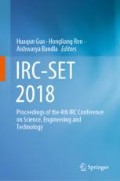Abstract
Autonomous vehicle technology is an expansively researched area of transport that aims to tackle long-standing problems of traffic such as congestion, safety and efficiency. Many of these vehicles combine automated driving with communication among vehicles and infrastructure to bring about a seamless driving experience that would not have been possible with human driving. The development of computer simulations for such vehicles aims to address concerns on whether the benefits proposed by autonomous vehicle makers can be realized in various traffic environments. This paper assesses the efficiency of autonomous vehicles that are introduced on an arterial road network with features similar to Singapore’s road networks. A cellular automata simulation has been developed that considers vehicle-to-vehicle communication abilities of autonomous vehicles. A traffic data collection algorithm based on web traffic services was developed to estimate real-time travel times along each stretch of road in the network simulation, from which autonomous vehicles can optimize their speed and route for a faster journey time. Based on preliminary results, the simulation was tested under multiple traffic densities and situations. The results display interesting interactions between vehicles and road elements such as lanes and traffic lights, which has allowed both autonomous and non-autonomous vehicles to travel to their designated destination faster when autonomous vehicles have been introduced.
Access this chapter
Tax calculation will be finalised at checkout
Purchases are for personal use only
References
Tan, C. K., & Tham, K. S. (2014). Autonomous vehicles, next stop: Singapore. Journeys, 5–11.
Litman, T. (2017). Autonomous vehicle implementation predictions (p. 28). Victoria Transport Policy Institute.
Gora, P., & Rüb, I. (2016). Traffic models for self-driving connected cars. Transportation Research Procedia, 14, 2207–2216.
Hu, J., Kong, L., Shu, W., & Wu, M. Y. (2012, December). Scheduling of connected autonomous vehicles on highway lanes. In: 2012 IEEE Global Communications Conference (GLOBECOM) (pp. 5556–5561). IEEE.
The Rise of a Robotic Dawn in Services Industry. (2017, January 2). Retrieved from http://www.todayonline.com/singapore/rise-robotic-dawn-services-industry.
Singapore to Start Trials of Driverless Trucks for Port Transport. (2017, January 9). Retrieved from http://www.channelnewsasia.com/news/singapore/singapore-to-start-trials-of-driverless-trucks-for-port-transpor-7558490.
Nagel, K., & Schreckenberg, M. (1992). A cellular automaton model for freeway traffic. Journal de Physique I, 2(12), 2221–2229.
Schadschneider, A., Chowdhury, D., Brockfeld, E., Klauck, K., Santen, L., & Zittartz, J. (2000). A new cellular automaton model for city traffic. In Traffic and Granular Flow ’99 (pp. 437–442). Berlin, Heidelberg: Springer.
Gora, P. (2009). Traffic simulation framework—A cellular automaton-based tool for simulating and investigating real road network traffic. Recent Advances in Intelligent Information Systems, 641–653.
Herrera, J. C., Work, D. B., Herring, R., Ban, X. J., Jacobson, Q., & Bayen, A. M. (2010). Evaluation of traffic data obtained via GPS-enabled mobile phones: The Mobile Century field experiment. Transportation Research Part C: Emerging Technologies, 18(4), 568–583.
Knospe, W., Santen, L., Schadschneider, A., & Schreckenberg, M. (2002). A realistic two-lane traffic model for highway traffic. Journal of Physics A: Mathematical and General, 35(15), 3369.
Author information
Authors and Affiliations
Corresponding author
Editor information
Editors and Affiliations
Rights and permissions
Copyright information
© 2019 Springer Nature Singapore Pte Ltd.
About this paper
Cite this paper
Yim, Q.Y., Wong, K.Y.C. (2019). Simulation-Based Analysis of a Network Model for Autonomous Vehicles with Vehicle-to-Vehicle Communication. In: Guo, H., Ren, H., Bandla, A. (eds) IRC-SET 2018. Springer, Singapore. https://doi.org/10.1007/978-981-32-9828-6_31
Download citation
DOI: https://doi.org/10.1007/978-981-32-9828-6_31
Published:
Publisher Name: Springer, Singapore
Print ISBN: 978-981-32-9827-9
Online ISBN: 978-981-32-9828-6
eBook Packages: Biomedical and Life SciencesBiomedical and Life Sciences (R0)

